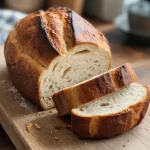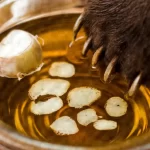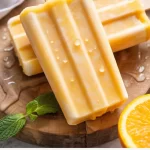I absolutely love this apple jelly recipe because it combines the nostalgic scent of simmering apples with the rewarding, hands-on process of canning, reminding me of simpler times and homemade goodness. Plus, there’s something incredibly satisfying about spreading my own clear, amber-colored jelly on toast, knowing it’s made from scratch with love and patience.

I adore the process of creating eye-catching recipes, and a jelly made from apples is a simple and delightful way to capture the essence of fall and the natural sweetness of the fruit. Four pounds of fresh apples (with the peels on), combined with five cups of water and two tablespoons of lemon juice, infuse this recipe with flavor.
Powders jell made from fruit pectin ensure that the spreadable consistency is achieved. This fall pantry staple packs a punch when it comes to vitamins and is a simple (and gorgeous) alternative to apple butter.
It is sweet and luscious, and perfect on a biscuit.
Ingredients

- Apples: High in fiber and vitamin C; natural sweetness.
- Lemon Juice: Adds tartness; rich in vitamin C.
- Sugar: Sweetening agent; preserves jelly.
- Fruit Pectin: Thickens jelly; derived from fruit.
Ingredient Quantities
- 4 pounds of apples, washed and chopped (including cores and peels)
- 5 cups of water
- 2 tablespoons of lemon juice
- 1 package (1.75 oz) of powdered fruit pectin
- 5 cups of granulated sugar
Instructions
1. Put the chopped apples, cores and peels included, into a large stockpot. Pour in 5 cups of water, then set the heat to medium-high and bring it to a boil. Once it’s at a rolling boil, reduce the heat and let it simmer for 45 minutes, stirring occasionally to ensure that everything gets soft and mushy.
2. Following the simmering stage, transfer the apple concoction to a jelly bag or a large fine-mesh strainer. This should be lined with cheesecloth and set over a bowl. Let this assembly hang out in your refrigerator overnight, dripping steadily into the bowl. Do not squeeze the bag. It is important that you do not do this; if you do, your jelly will not be clear.
3. Pour 5 cups of the apple juice into the container. If the juice doesn’t reach 5 cups, fill it to the mark with water.
4. Measure out the apple juice and pour it into a very large, heavy-bottomed pot. Stir in 2 tablespoons of lemon juice.
5. Slowly mix in the powdered fruit pectin and, on high heat, bring the mixture to a fast, bubbling boil, stirring all the while.
6. Add in all 5 cups of granulated sugar at once, and stir to dissolve.
7. Return the combination to a rollicking boil. Boil hard for 1 minute, stirring constantly. Remove from heat and skim off any foam with a metal spoon.
8. Ladle the hot jelly right away into jars that have been sterilized, leaving about a 1/4 inch of space between the jelly and the top of the jar. Wipe the rims of the jars clean, and seal them with lids and rings that have also been sterilized.
9. Heat the closed jars in boiling water for 5 minutes to ensure they are tightly sealed and the contents are preserved.
10. With tongs, carefully take out the jars and allow them to cool on a kitchen towel. After they have completely cooled, check the seals. Any jars that are not sealed go in the refrigerator. The rest can be stored at room temperature.
Equipment Needed
1. Large stockpot
2. Stove or cooktop
3. Jelly bag or large fine-mesh strainer
4. Cheesecloth
5. Bowl
6. Container for measuring liquid
7. Very large heavy-bottomed pot
8. Stirring spoon
9. Ladle
10. Sterilized jars with lids and rings
11. Metal spoon
12. Tongs
13. Kitchen towel
FAQ
- Can I use different types of apples?Indeed, using both sweet and tart varieties in a blend is optimal for achieving a balanced and flavorful jelly.
- Why are the cores and peels included?Natural pectin, which occurs in the form of a colloidal substance, is present in the cores and peels of fruit. This is one of the reasons that jelly made from fruit is an exceptionally good quality product. The pectin in the jelly derived from fruit cores and peels gives it a good gel structure.
- Can I reduce the amount of sugar in the recipe?It is advised that the amount not be decreased because sugar is extremely important for jelly to set and be preserved.
- What is the role of lemon juice in this recipe?Acidity and color preservation. Lemon juice provides necessary acid for the pectin to do its work. Jelly cannot be made without a certain amount of acid (necessary for the pectin to gel) and without a certain control over pH (the more pH is controlled, the less color and flavor compounds degrade during storage).
- How can I tell when the jelly has reached the gel point?Test the thickness: Put a bit on a cold spoon and see if it thickens. Use a candy thermometer to reach 220°F.
- Can I use liquid pectin instead of powdered?Indeed, but for optimum results, adhere to the directions on the liquid pectin package, as the method may vary a bit.
Substitutions and Variations
Crabapples or a mixture of tart apples can be used instead of regular apples to achieve a more complex flavor.
To achieve a diverse citrus profile, swap lemon juice for either lime or orange juice.
Instead of powdered fruit pectin, you can use liquid fruit pectin, but make sure to follow package instructions for the correct conversion.
You can use honey or agave syrup to replace part or all of the granulated sugar, though this may have an effect on the jelly’s set and flavor.
Pro Tips
1. Use High-Quality Apples: Choose apples that are fresh and firm to ensure the best flavor and natural pectin content. A mix of different apple varieties can also add depth to the flavor profile of your jelly.
2. Strain Gently for Clarity: When straining the apple mixture, be patient and let it drip naturally through the jelly bag or cheesecloth. Avoid the temptation to squeeze the bag to ensure your jelly remains clear and free of cloudiness.
3. Achieve the Right Consistency: Conduct a pectin test on a small spoonful of the jelly before jarring by placing it on a cold plate and letting it sit for a minute. If it wrinkles or holds shape when pushed, it’s ready. If not, continue boiling for another minute and test again.
4. Skim Foam Carefully: After boiling, carefully skim off any foam from the surface to ensure a smooth jelly texture. This step helps prevent imperfections and enhances the clarity and appearance of the final product.
5. Verify Proper Seals: After processing the jars in the boiling water bath, listen for the “pop” sound, which indicates a successful seal. It’s crucial to check that each lid is concave and doesn’t flex up and down when pressed. Unsealed jars should be refrigerated and used first.

Apple Jelly Recipe
My favorite Apple Jelly Recipe
Equipment Needed:
1. Large stockpot
2. Stove or cooktop
3. Jelly bag or large fine-mesh strainer
4. Cheesecloth
5. Bowl
6. Container for measuring liquid
7. Very large heavy-bottomed pot
8. Stirring spoon
9. Ladle
10. Sterilized jars with lids and rings
11. Metal spoon
12. Tongs
13. Kitchen towel
Ingredients:
- 4 pounds of apples, washed and chopped (including cores and peels)
- 5 cups of water
- 2 tablespoons of lemon juice
- 1 package (1.75 oz) of powdered fruit pectin
- 5 cups of granulated sugar
Instructions:
1. Put the chopped apples, cores and peels included, into a large stockpot. Pour in 5 cups of water, then set the heat to medium-high and bring it to a boil. Once it’s at a rolling boil, reduce the heat and let it simmer for 45 minutes, stirring occasionally to ensure that everything gets soft and mushy.
2. Following the simmering stage, transfer the apple concoction to a jelly bag or a large fine-mesh strainer. This should be lined with cheesecloth and set over a bowl. Let this assembly hang out in your refrigerator overnight, dripping steadily into the bowl. Do not squeeze the bag. It is important that you do not do this; if you do, your jelly will not be clear.
3. Pour 5 cups of the apple juice into the container. If the juice doesn’t reach 5 cups, fill it to the mark with water.
4. Measure out the apple juice and pour it into a very large, heavy-bottomed pot. Stir in 2 tablespoons of lemon juice.
5. Slowly mix in the powdered fruit pectin and, on high heat, bring the mixture to a fast, bubbling boil, stirring all the while.
6. Add in all 5 cups of granulated sugar at once, and stir to dissolve.
7. Return the combination to a rollicking boil. Boil hard for 1 minute, stirring constantly. Remove from heat and skim off any foam with a metal spoon.
8. Ladle the hot jelly right away into jars that have been sterilized, leaving about a 1/4 inch of space between the jelly and the top of the jar. Wipe the rims of the jars clean, and seal them with lids and rings that have also been sterilized.
9. Heat the closed jars in boiling water for 5 minutes to ensure they are tightly sealed and the contents are preserved.
10. With tongs, carefully take out the jars and allow them to cool on a kitchen towel. After they have completely cooled, check the seals. Any jars that are not sealed go in the refrigerator. The rest can be stored at room temperature.
















